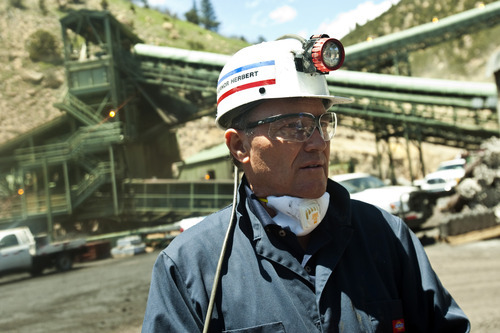This is an archived article that was published on sltrib.com in 2012, and information in the article may be outdated. It is provided only for personal research purposes and may not be reprinted.
A little-known state panel Thursday approved the final multimillion-dollar piece of funding needed to build a new road between Utah's largest coal mine and Emery County's coal-fired power plants.
The Permanent Community Impact Fund Board, which doles out money from mineral leases on federal lands in the state, gave the Quitchupah Road project the largest single chunk of a record $95 million award for water pipes, sewers, roads and other community projects in rural Utah.
That sum was the biggest the CIB ever approved in a single sitting since its creation in 1978. And it put the board's grand total spending in rural Utah at just below $1 billion.
The Quitchupah Road accounted for nearly $17.4 million of the funds signed off on Thursday, and past board promises of more than $12.5 million will cover the estimated $30 million construction.
"This is a perfect example of the way a portion of this [mineral-lease] money should always be spent," said Mike McCandless, economic director for neighboring Emery County.
Conceived about 15 years ago, the 10.5-mile road in Sevier County will shave about 46 miles from the coal-truck trip along Acord Lakes Road, down Interstate 70, up State Route 10 and to the power plants.
The power plants take about 60 percent of the Sufco mine's coal, which is hauled place-to-place more than 250 times a day, six days a week. And the new route will mean about 5 million miles less wear-and-tear and fleet savings of about $2.5 million each year, board chairman Gordon Walker said.
The public will also have access to the road.
"We see Quitchupah Road as a positive," said McCandless, noting that the benefits will spill over even a county away. "It will give our workers easier access to the mine for employment. It will make easier access for the trucks from the mines for our power plants."
Dennis O. Larson, treasurer of the Sevier County Roads Special Service District No. 1, echoed that view.
"It puts people to work in our county building the road," he said, noting that the road will improve overall efficiency. "The mine is the biggest in the state, and anything that helps them helps Sevier County."
Larson told the CIB Thursday that the road's estimated cost has increased over the past five years since the route changed, partly to protect important American Indian sites. With just one more bureaucratic hurdle left — approval from the U.S. Army Corps of Engineers — work can begin as early as April and should be ready to use by fall of 2013, he said.
Former Emery City Mayor Gary Petty said he and a few other ranchers have been concerned about having to share the road with the big coal trucks as they haul their stock up and down the steep mountainside in spring and fall, a tradition that's taken place for generations over an old Jeep trail. They've been hoping the 30-foot-wide road would be supplemented with a separate "driveway," but there's been no word on that yet, he said.
"We're not against the road," he said. "We just want to have access for our cattle."
Dick Cumiskey of the Sevier Citizens for Clean Air and Water noted that he's no fan of coal mines or coal-fired power plants. His group successfully fought a coal-fired power plant planned for Sigurd, but he supports the road to help keep miners employed.
And there might even be some environmental benefits with the reduction in truck traffic, he said. "Overall, it should help make an improvement."
Each month, the board's 11 members hear funding-request pitches from communities affected by mining. Three times a year, they award grants and loans for water-system improvements, new sewer lines, community centers and other projects they deem worthy.
The fund has grown as the state's portion of mineral lease royalties from work on federal lands has swelled. The Utah Division of Oil, Gas and Mining reported that as of the end of 2011, there were more than 10,300 producing oil and gas wells in the state — the highest number ever.
The fund also grows with repayment of past loans from projects around the state.
"As funds go up," said Walker, "the size of the projects go up."
On Thursday morning, the board voted to fund nearly $57 million worth of projects before a half-hour had passed, accelerating the panel's approval rate to more than $1 million a minute, noted Walker.
Twitter: @judyfutah —
More online
O Learn more about the Permanent Community Impact Fund Board > bit.ly/yoIIzQ —
In other action
Another board action Thursday was to change a $7 million low-interest loan to a no-interest loan to help build a new water system in a northwestern Kane County vacation community, Zion View Estates.
The project would help owners of 250 homes and lots after state regulators ordered the community last summer to correct its water safety problems immediately or face a system shutdown. State Rep. Mike Noel, R-Kanab, and manager of the Kane County Water Conservancy District, has estimated the entire project will cost $18.7 million, and he is seeking grants and loans from a variety of sources to help pay for it.



